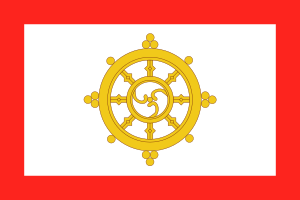Sikkimese people facts for kids

Flag of Sikkim
(1967–1975) |
|
| Regions with significant populations | |
|---|---|
| 610,577 | |
| 610,577 (2011) | |
| Languages | |
| Religion | |
| Majority: Minority: •Christianity • Bon •Mun •Kiratism •Animism | |
| Related ethnic groups | |
|
|
The Sikkimese are the people who live in the Indian state of Sikkim. Sikkim is a place with many different groups of people. These groups have lived there for a long time.
Since the 1600s, three main groups have been important. These are the Lho, Mon, and Tsong.
- The 'Lho' are the Bhutia people. They came from Southern Tibet.
- The 'Mon' are the Lepchas. They lived in the lower Eastern Himalayas.
- The 'Tsong' are the Limbus, another tribe in Sikkim.
Sikkim has also been home to the Kirati tribes for thousands of years. Today, the population of Sikkim includes Lepchas, Bhutias, and Nepalese people. These groups settled in Sikkim at different times in history.
Contents
Who Lives in Sikkim?
Sikkim is a state with many different communities. People there belong to various ethnic and language groups. The Anthropological Survey of India has found 21 communities in Sikkim. More than 13 different languages are spoken in the state.
Communities and Tribes of Sikkim Rai (13.4%) Chhetri (12.22%) Limbu (9.79%) Bhutia (8.57%) Lepcha (7.94%) Bahun (6.96%) Tamang (6.8%) Gurung (5.87%) Sherpa (4.45%) Kami (4.25%) Newar (3.73%) Magar (2.69%) Damai (1.96%) Thami (0.9%) Bhujel (0.6%) Sunuwar (0.65%) Sanyasi/Giri (0.46%) Sarki (0.2%) Yakkha Dewan (0.003%) Others (9.34%)
Main Ethnic Groups
Many different groups make up the population of Sikkim. The Rai are the largest group. The Chhetri people are the second largest.
Among the groups listed as Scheduled Castes, the Kami are the biggest. They are followed by the Damai and Sarki communities. The smallest groups in Sikkim are the Dewan and the Thami.
Languages Spoken in Sikkim
The official languages of Sikkim are Nepali, Sikkimese, Lepcha, and English. Other languages are also official to help preserve culture. These include Gurung, Limbu, Magar, Mukhia, Newar, Rai, Sherpa, and Tamang.
Nepali is the most common language spoken by everyone in Sikkim. Sikkimese (Bhutia) and Lepcha are spoken in certain areas. English is also widely understood. Other languages spoken include Dzongkha, Groma, Hindi, Majhi, Majhwar, Thulung, Tibetan, and Yakha.
Festivals and Celebrations
Sikkim has many colorful festivals. These come from the Nepali, Bhutia, and Lepcha cultures. People celebrate Hindu, Buddhist, and local festivals.
Some popular festivals are:
- Dashain and Tihar (Hindu festivals)
- Losar (Tibetan New Year)
- Saga Dawa (Buddhist festival)
- Sakewa (Kiranti festival)
- Tendong Lho Rumfaat (Lepcha festival)
- Losoong/Namsoong (Sikkimese New Year)
- Indra Jatra (Nepali festival)
- Sonam Lhosar and Tamu Lhosar (Tamang and Gurung New Year)
- Chasok Tangnam (Limbu festival)
- Maghe Sankranti (Hindu festival)
- Buddha Jayanti (Buddha's birthday)
- Rama Navami (Hindu festival)
Religions in Sikkim
Sikkim is home to people of many faiths. The two largest religions are Hinduism and Buddhism.
Buddhism
Vajrayana Buddhism is the second-largest religion in Sikkim. About 28% of the people follow it. Before Sikkim joined India, Buddhism was the official state religion. Sikkim has 75 Buddhist monasteries. Some of these are very old, dating back to the 1700s.
Hinduism
Hinduism is the main religion in Sikkim. About 64% of the people are Hindu. This grew as more Nepali Hindu people moved to Sikkim. There are many Hindu temples in the state. The Kirateshwar Mahadev Temple and the Char Dham are very well-known.
Other Religions
Christians make up about 10% of the population. Many are descendants of Lepcha people who became Christian in the late 1800s. The Evangelical Presbyterian Church of Sikkim is the largest Christian group.
Other smaller religious groups include Muslims and Jains. Each of these makes up about one percent of the population. The traditional religion of the native Lepcha people is Mun. This is an animist practice, meaning they believe spirits are in nature. It exists alongside Buddhism.

